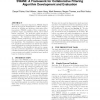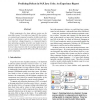861 search results - page 12 / 173 » Predicting Attack-prone Components |
HCI
2009
13 years 5 months ago
2009
The posterior parietal cortex (PPC) plays an important role in motor planning and execution. Here, we investigated whether noninvasive electroencephalographic (EEG) signals recorde...
SIGIR
2000
ACM
13 years 12 months ago
2000
ACM
We present a Java-based framework, SWAMI (Shared Wisdom through the Amalgamation of Many Interpretations) for building and studying collaborative filtering systems. SWAMI consist...
HPCA
2000
IEEE
13 years 12 months ago
2000
IEEE
Abstract—Sharing patterns in shared-memory multiprocessors are the key to performance: uniprocessor latencytolerating techniques such as out-of-order execution and non-blocking c...
ICSE
2009
IEEE-ACM
14 years 2 months ago
2009
IEEE-ACM
Which components of a large software system are the most defect-prone? In a study on a large SAP Java system, we evaluated and compared a number of defect predictors, based on cod...
EXPERT
2007
13 years 7 months ago
2007
Prediction is an important component in a variety of domains. Intelligent systems that can predict future events are better enabled to make more informed, and therefore more relia...


